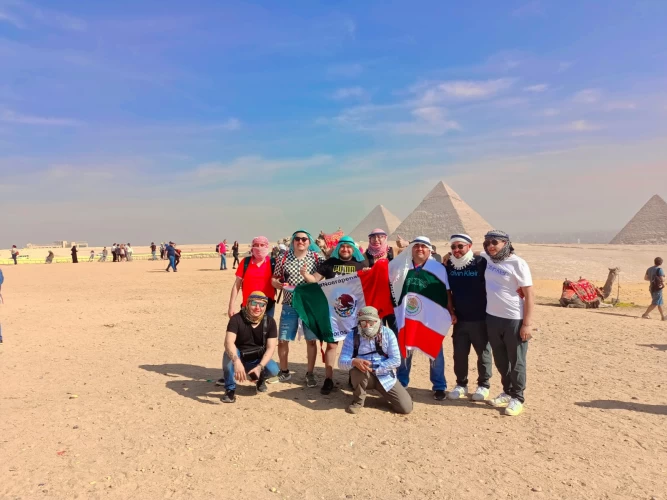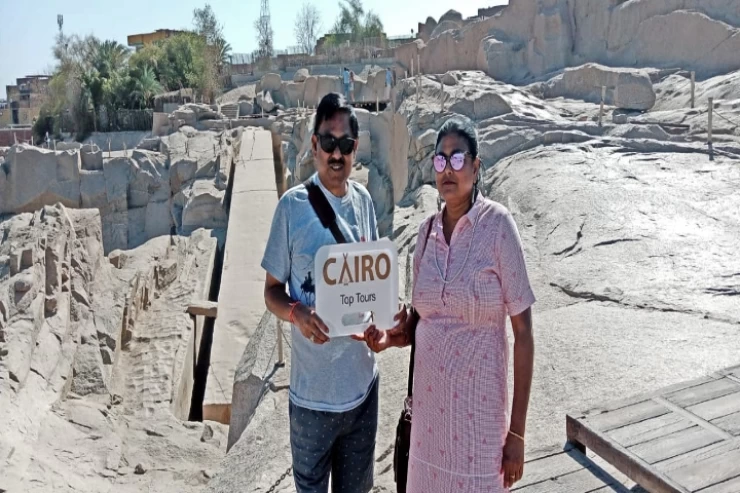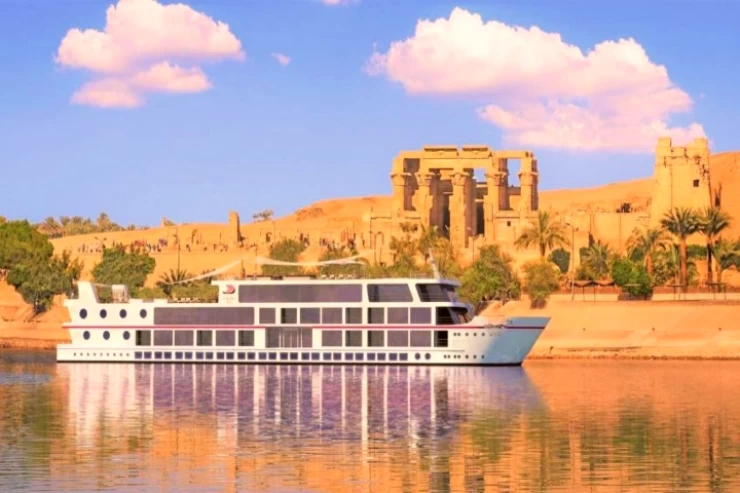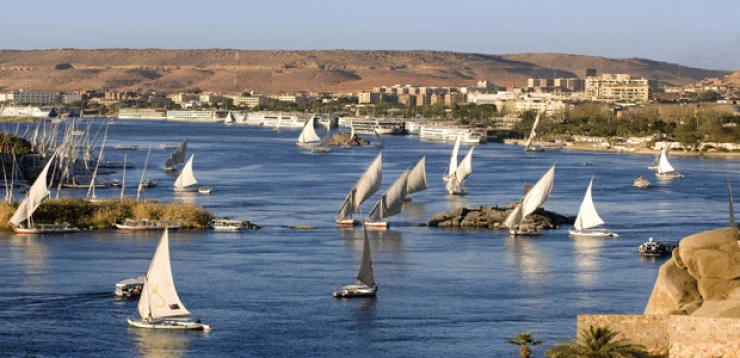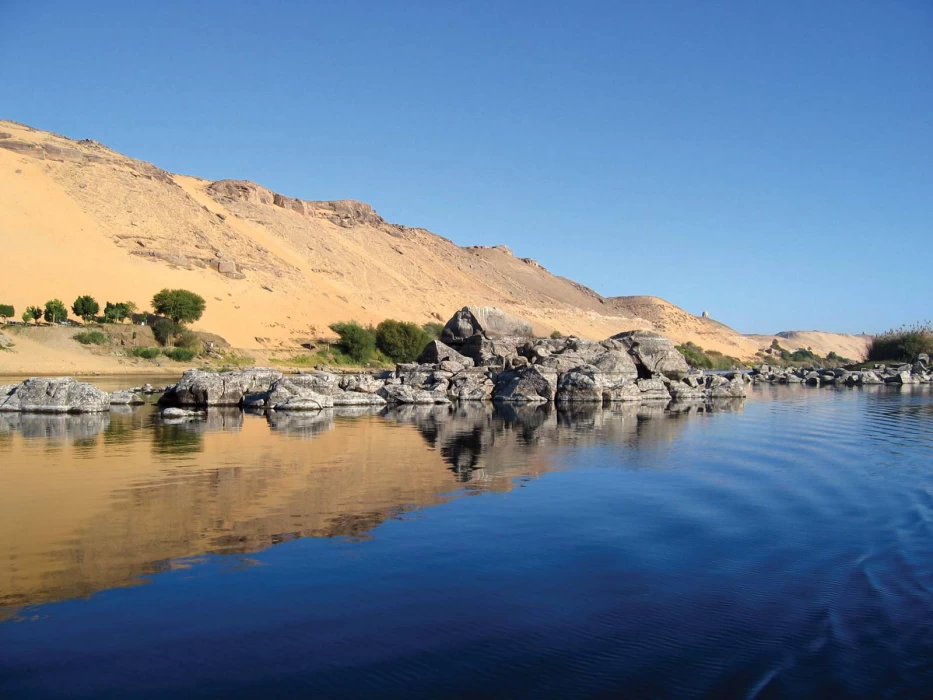
Der Nil
Der Nil
Sind Sie vollständig geimpft?
Dann müssen Sie bei Ihrer Ankunft am internationalen Flughafen von Kairo keinen PCR-Test vorlegen, um einen einmaligen Urlaub im Land der Pharaonen zu genießen.
Der Nil ist der längste Fluss der Welt, da er sich südlich des Äquators erstreckt und nach Nordosten fließt. Das 3349000 km2 große Becken umfasst 11 afrikanische Länder: "Uganda, Eritrea, Ruanda, die Demokratische Republik Kongo, Tansania, Burundi, Kenia, Äthiopien, Südsudan, Sudan und Ägypten."
Der Nil gilt vor Tausenden von Jahren als Hauptgrund für die Entwicklung der ägyptischen Zivilisation. Dies geht aus den Schriften des antiken griechischen Historikers Herodot hervor, der sagte, Ägypten sei das Geschenk des Nils, wo die trockenen Wüstenländer in Ägypten fruchtbar wurden Land aufgrund der Bildung von Schlickablagerungen entlang der Ufer des Nils, die zum Wachstum der alten ägyptischen Zivilisation führten. Diese wurde von Weizen, Flachs und Papyrus entlang der Ufer des Nils kultiviert
Der Nil in Ägypten erstreckt sich von der Nordgrenze des Nassersees in Assuan nördlich von Kairo, wo der Nil geteilt wird, um das Nildelta in zwei Zweige zu bilden, Rashid und Damietta.
In der Antike ließen sich die primitiven Ägypter am Ufer des Nils nieder, wo sie einfache Häuser und Hütten für die Unterbringung bauten, viele Ernten anbauten und seitdem die ersten Schritte zum ägyptischen Ruhm begonnen hatten. Der Anbau war der Ausgangspunkt, als der Nil bewässerte und Schlickablagerungen trug, die das Land entlang des Niltals bedeckten und es fruchtbar machten.
Weizen war das erste Produkt, das die alten Ägypter kultivierten, abhängig von den Nilfluten als Lösung für die Bedrohung durch Hunger und Nahrungsmittelmangel zu dieser Zeit. Auf der anderen Seite benutzten sie einige Tiere wie Wasserbüffel und Kamele zum Essen, Pflügen und Tragen von Waren.
Mehr als 95% der Bevölkerung der Ägyptischen Republik lebt am Ufer des Nils. Auf diese Weise ist das Niltal eines der am dichtesten besiedelten Gebiete der Welt mit einer durchschnittlichen Bevölkerung von etwa 3.820 Menschen pro 1,61 Quadratmeter Kilometer, und der Grund dafür ist, dass der Nil das Lebenselixier der ägyptischen Republik ist, in der Landwirte große Mengen verschiedener Kulturen wie Zitrusfrüchte, Baumwolle, Weizen, Zuckerrohr, Hülsenfrüchte und Sorghum produzieren.
Trotz des Erfolgs von Agrarprogrammen im Nilbecken sind die Nilströme in einigen Ländern immer noch gering, weshalb die Nilbeckeninitiative 1999 begann. Um diesen Ländern zu helfen, den Fluss zu fördern
Als Teil der Interessen der alten Pharaonen am religiösen Leben und ihres Bestehens, viele Götter und Göttinnen für physische Elemente zu erschaffen, ehrten sie den Nil, indem sie Sobek „Gott des Nils“ schufen, oder er wurde „Gott des Krokodils“ genannt Der Gott eines Mannes mit einem Krokodilkopf stand für Fruchtbarkeit, Feuchtgebiete, Medizin und plötzlichen Tod.
Der Nil gilt als der Schweiß von Sobek. Ein anderer Gott, der mit dem Nil im alten Ägypten verwandt ist, ist "Hapi", genannt "Herr des Flusses, der Vegetation bringt" oder "Herr der Fische und Vögel der Sümpfe", der Gott der jährlichen Überschwemmungen des Nils, die den Wasserstand stark kontrollierten.
-
Erleben Sie den Zauber Ägyptens, wo alles beginnt, mit dem professionellen Team von Cairo Top Tours. Starten Sie jetzt Ihr Abenteuer und erleben Sie den besten Urlaub in Ägypten.
-
Sie finden hier die besten Ägypten-Osterangebote und -Urlaube 2022. Der Frühling in Ägypten ist perfekt und die Atmosphäre ist unsagbar schön. Wir organisieren tolle und unterhaltsame Ägypten Ausflüge wie Kairo Tagestouren. Schauen Sie sich unsere Ausflüge und Reisen mit angemessenen Preisen an, die für alle Arten von Touristen im Jahr 2022 geeignet sind, sowie Ägypten Landausflüge, zusätzlich zu Kairo Tagestouren vom Flughafen und Kairo Zwischenlandung Tour.
-
Sie können das antike Theben erkunden, beginnend mit dem Tal der Könige und dem Westufer von Luxor, sowie den Karnak-Tempel und den Luxor-Tempel. Ägypten Touren erweitern, um den Tempel von Edfu von Gott Horus der Falke, und Kom Ombo Tempel und Abu Simbel zu decken. All dies während Assuan-Tagestouren und Luxor-Tagestouren.
-
Das Rote Meer ist einer der malerischsten Orte, die Sie in Ägypten besuchen können, genießen Sie einige Meeresabenteuer und Wanderaktivitäten wie Hurghada Tagestouren und Sharm El Sheikh Ausflüge. Sichern Sie sich jetzt Ihren Platz in unseren Ägypten-Reisepaketen und Wüstensafari-Trips, um von Kairo aus die Oasen Siwa, Bahriya und Farafra sowie die Oasen Dakhla und Kharga zu bereisen! Wir sehen uns wieder. Wir von Cairo Top Tours scheuen keine Mühen, um Ihnen ein wertvolles Plus an unseren Touren und Ausflügen in Ägypten zu bieten.
Disregarding its claim to being the longest river in the world, the Nile epitomizes all that is Egypt in terms of geography, history, and culture. The Nile is located in the northeastern region of Africa and is about 6,650 kilometers long (4,130 miles), running through 11 different countries before emptying into the Mediterranean Sea. Nevertheless, the most well-known portion of the river is certainly in the country of Egypt, where not only has the river formed the present-day geography of the place but also sustained one of the most ancient and greatest civilizations in the world. It is often referred to as the ‘Gift of the Nile’. Most of the wealth, progress, and history of Egypt have revolved around this river.
Egypt boasts of long stretches of deserts, but it is interesting to note that the Nile River has succeeded in forming a vegetative zone in the region otherwise characterized by dry lands. Without the Nile River, the majority of regions within this nation’s borders would more likely than not be empty and unproductive land. It supplies water, which is sourced for farming, business, and even household use. In ancient times, the Nile used to spill over its banks, and every year the lands along the river, such as the region around the Nile, received rich alluvial deposits that were excellent for farming. These floodwaters every year without fail were perfect for growing crops for the ancient Egyptians, who grew different crops such as wheat, barley, and flax, which were the main food and agricultural income of this community.
Today, while the Aswan Dam was built in 1970, which led to the complete control of tree flooding and therefore the abolition of the age-old flood regime, the Nile River is still of great importance for agriculture in Egypt. Filmy green container siding strips that fit perfectly along the banks of the river, which is reminiscent of the shape of the river, sharply contrast with the yellow sand canvas of the desert, indicating that the Nile River is of key importance to the people of Egypt.
The Nile was an important resource for agriculture, but its relevance does not end there; much of today’s world owes its existence to Egypt as we know it. Civilizations flourished on both banks of the ancient Nile as it provided not just water and rich alluvial plains, but also integrated the two banks using transport and communication. The river was crisscrossed by boats transporting goods, people, and ideas, effectively bridging the gap between Upper and Lower Egypt and emerging as one of the most powerful kingdoms.
Furthermore, the river found its place also in the divine and cultural aspects of the ancient Egyptians. The floods of the river, which were very important for agriculture, were treated in ancient times as a curse from Hapi, the protective god of the fertile Delta and the Nile. The river was also linked with the idea of death and what came after it. The Egyptians believed that the east side of the Nile River where the sun rose was the region of the living, while the west side where sunset occurred was the realm of the dead. This explains why some of the country’s most popular structures, including the Great Pyramids and the tombs in the Valley of Kings, are located on the western bank of the river.
The legacy of the Nile is inscribed in the very topography of the nation of Egypt, with nearly all its iconic representations located along the banks of the river. In Cairo, for instance, west of the Nile runs the Giza Plateau, which houses the Great Pyramid among other pyramids, and the infamous Sphinx that has stood for more than 4500 years. The stones used to create these buildings rose from within the depths of the Nile and were transported therein, thus revealing the contribution of the river towards the architectural peculiarity of Egypt.
Going further down south to Luxor, yet another ancient hub, the Nile cuts across it. East Bank consists of the vast temples of Karnak and Luxor, which were the places of worship for the exalted pharaohs. West Bank is characterized by the flat surface of the Valley of the Kings, which hosts the burial places of the most powerful kings’ in Egyptian history, with the famous King Tut’s tomb being one of them. It was the Nile that linked those cities and the temples, and the Nile waters flowed in bringing the resources necessary for erecting such remarkable edifices.
One of the striking cases of the power of the Nile on Egyptian monuments might be the temples of Abu Simbel, which are found on the southern border of Egypt close to Sudan. Colossal temples were carved by the mountain by Ramses II, and since they are located close to the river, there was a risk when the Aswan High Dam was being built. In an astonishing engineering accomplishment, the temples were moved to a higher location to protect them from the adverse effects of the water levels of Lake Nasser, an enormous reservoir that was built because of the dam. At this point, they are both an ancient and contemporary reminder of the connection that Egypt has with the Nile.
The Nile is still an integral aspect of modern-day Egypt. The river is still used for irrigation and even provides drinking and industrial water. It has also maintained its relevance as a waterway, and especially as a tourism-based route. Cruises on the Nile between Luxor and Aswan allow tourists to experience the beauty of the river and, along the way, some of the exotic historic sites of Egypt. This pace of the river sets the mood for temple, tomb, and village raids, which are fun-beholding sights of historical Egypt.
The Nile has been a major factor in the growth of cities like Cairo, Aswan, and Luxor. In Cairo, the Nile passes through the very middle of the populated city, providing a serene gate away from the noisy road. Corniche El Nile, which is a wall fronting the river in the city, is frequented by people, both locals and tourists, who go there to see the river, and particularly sunsets are breathtaking. Calm sailing wooden boats called feluccas move on top of the river, recalling the magic of the serene Nile.
Aswan is characterized by the majestic flow of the Nile that meanders, surrounded by patches of granite and tiny islands, providing an ideal ambiance to learn about the Nubian culture and Philae Temple. The slower-paced atmosphere created by the clear waters in Aswan makes it one of the most captivating places along the Nile, where visitors feel relaxed as if everything is flowing with the river at a gentle pace.







